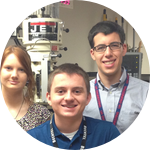About This Project
Regenerative energy technology in motor vehicles incorporates capacitors, which stabilize the energy produced by the system. However, current conductive materials inside these capacitors are limited by their natural properties. Our project seeks to integrate graphene, a superconductive nanomaterial, into a small scale regenerative energy system to improve the range of an electric vehicle.Ask the Scientists
Join The DiscussionWhat is the context of this research?
Graphene is among the most electrically and thermally conductive materials currently known in materials science. It is a relatively new discovered material that is 50% more conductive than pure copper.
From a closer perspective, Graphene is a single atom layer thick of carbon, where its large molecular surface area make it an ideal material for supercapacitors. When used in combination with a regenerative system, supercapacitors can be applied to electric vehicles to provide extended vehicle range.
The application of graphene supercapacitors will enable the most efficient use of a regenerative system. Our project will explore the applications and implementation graphene.
What is the significance of this project?
This project will investigate how Graphene’s high amount of molecular surface area can be used in a capacitor device. Graphene has a low resistance to electricity, so this project will also examine how the material reacts to high current applications.
The graphene supercapacitors will collect energy from an alternator, where a battery isolator will combine the output of a supercapacitor and battery bank. In effect, the system will convert mechanical energy to electrical energy, which will then be used to lessen the electrical load on the batteries. If successful, this project may provide valuable data into the advancement of regenerative systems for electrical vehicles.
What are the goals of the project?
Our primary goal is to implement a regenerative system utilizing graphene supercapacitors in an electric vehicle on a small scale. The graphene supercapacitors will be integrated into a golf cart.
Changes must be made to the cart’s transmission and an alternator must be added for the regenerative system. Once the graphene capacitor is inserted into the system tests will be conducted to determine the energy density and capacitance values of the graphene, efficiency of the regenerative system, and total range achieved with the addition of the supercapacitors.
Using this data, the graphene supercapacitors will be compared to current capacitive banks. We seek to discover more properties about graphene, and advance research into its high power applications.
Budget
Graphene is an exciting material, where its various uses and applications grow day after day. Understanding this concept, as students, we were compelled to contribute to the overall understanding of Graphene. If our project results and conclusions support our hypothesis, the outcome may transform current regenerative technology in electric / hybrid vehicles.
Thus, when we conceived the idea to implement graphene in an electrical vehicle, the majority of the concern came from the need to purchase new materials. We lack the necessary financial support from our school, and we cannot afford to support the project, ourselves. Experiment.com presents an opportunity for us to gather the needed financial support to pursue the project, and further advance graphene technology.
Meet the Team
Team Bio
Ryan Kunz is a student at the Center for Research Engineering Science and Technology and currently works for TOR Engineering as an Electrical Engineering Intern. He is fascinated with graphene and is passionate about contributing towards its development.Mark Jaffee is a student at the Center for Research Engineering Science and Technology and works for Gannett Fleming as a civil engineering intern. He is captivated by structures and electricity, designing the power management and mechanical systems for the project.
Kelsie Lucas is a student at the Center for Research Engineering Science and Technology and currently works for ACSS as an electrical engineering intern. She is proficient in CAD software, and handles the computer modeling for the project.
Additional Information
The main image at the top of the page is a three dimensional rendering on the atomic structure of graphene.
A picture of our workshop.

A picture of the graphene we synthesized in our lab.

An interior shot of the transmission that we will primarily be working with.
Project Backers
- 26Backers
- 102%Funded
- $1,613Total Donations
- $62.06Average Donation


